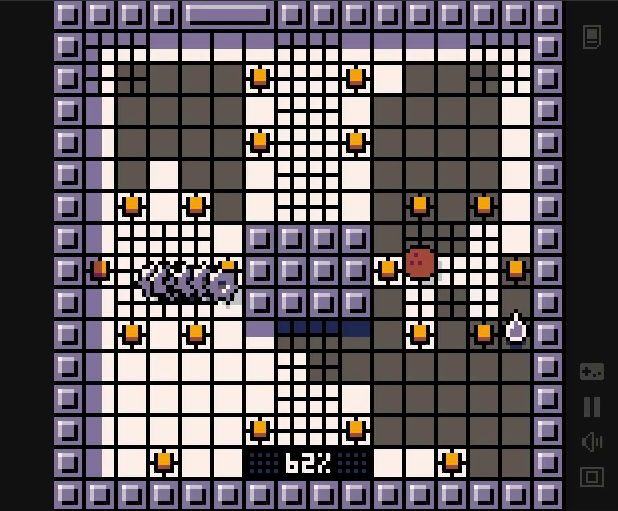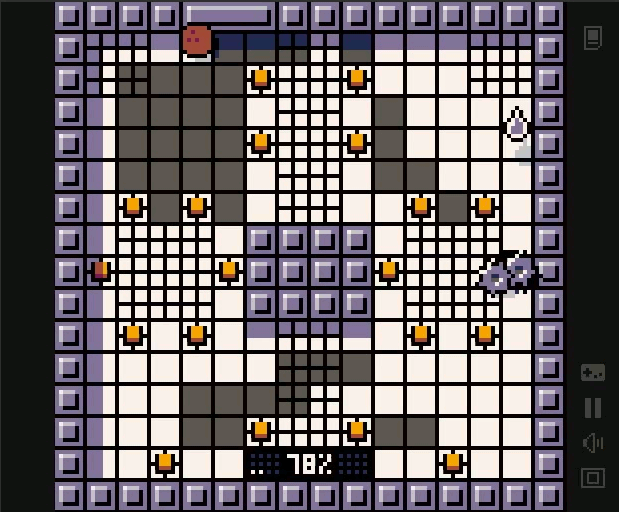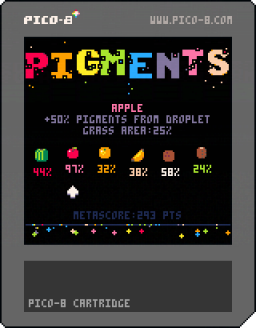As Pigments is quite tough, I've decided to write this guide on how to beat the four five levels I've managed to beat so far all the levels in the game, hoping to help others beat them too.
Changelog: Sept. 10, 2021: Added Coconut section Sept. 16, 2021: Expanded Coconut, late-level sections Sept. 26, 2021: Added Banana section Sept. 27, 2021: Updated Watermelon, Coconut, & RNG sections and added some more images Nov. 27, 2022: Small update to RNG section
Apple
While Apple is by far the easiest level to beat, in this game that doesn't mean as much as most. In my experience, there are two ways to approach Apple—a safer, slower strategy that can reliably lead to completing the level, and a much faster, more dangerous method that'll have a much lower success rate. You can see examples of the aggressive strats in the top runs on the leaderboard, and I've uploaded a demo of the safer strats below.
[center]Safety Strategy[/center] The safe strategy for Apple is pretty simple—use the first few batches of pigment to fill in the center, leaving the outer edges for last so you can jump to the safe squares when discs approach. By center, I mean all the squares at least 3 hops away from the grass. If you decide to follow this strategy, you should be able to fill in pretty much the entire center with the first 3 batches of pigment.
It should look like this (you may need to fill in a few more edge squares if the pigments appear in the corners):

You may still have to go to the center to collect pigment late in the level, but for the most part you can hide in the grass and bounce against the wall until your path is clear.
[center]Aggressive Strategy[/center] The aggressive strategy for Apple is to try to minimize the total number of jumps you need to pull off by using a serpentine/spiral movement from one batch of pigment to the next. The idea being that you create a continuous path, ideally leaving no gaps among the filled squares for later. In practice, leaving a gap while dodging quickly may be preferable to slowing down to figure out how not to leave a gap.
To minimize the amount of backtracking later in the level, you should try to fill in the corners whenever a batch is conveniently located near one, provided you don't have to bounce around dodging discs for too long to do so.
In the early stages of the level, you should largely be able to curve your path around the discs as necessary. The later stages are much dicier than the safe strategy, as you'll need to get comfortable with maneuvering in the center while 5-6 discs are out there.
[center]Level-specific attributes to bear in mind[/center]
- Although the grass squares are completely safe when you are on them, you can still be killed while jumping from the normal squares onto the grass if a disc is close enough.
- Each batch of pigment gives you 24 drops instead of 16 like the other levels.
- The max drops you can hold is 32 instead of 24 like the other levels, so filling at 8 or fewer doesn't lose any pigment.
- There are 146 squares to fill, so you must collect 7 batches to fill them all.
Watermelon
Watermelon is considerably tougher than Apple—its hitbox is larger, you need to collect more pigment/release more discs, the field of play is bigger, and the water squares leach your pigment. As such, using a similar safety strategy as in Apple won't improve your odds of success as much.
[center]Safety Strategy[/center] Like in Apple, the general safety strategy is to focus on filling in the squares furthest from the safe squares first, then getting the squares along the water later. However, as you can't move freely through the water while holding pigments, it's better to leave the squares nearest to water squares that are next to walls for last because you can bounce against the wall to clear out the discs without losing pigment.
Unlike Apple, you'll need more than 3 batches to do this, so you're likely to have to do some tricky dodging fairly early in comparison. Here's an example of what it may look like after 4 batches (from demo vid below):

[center]Aggressive Strategy[/center]
For Watermelon, there are a couple of options when you're ready to go after faster times. You can try to preferentially fill in the outermost (top/bottom/left/right) tiles early as you get the chance, leaving the middle spaces for later so you won't have to cover as much ground when more discs are loose. It'll look something like this early:

Alternatively, you can try to pick up the first few batches as quickly as possible, going straight from one to the next, and then fill in connected chunks during the middle portion of the level, wherever you find most convenient. This strategy works well with the RNG manipulation explained below; see this run for an example.
When going for fast times, you'll want to stay out of the water as much as possible while holding pigment—each drop you lose will cost you time. Due to the large hitbox and odd layout, staying on land requires anticipating trouble a bit earlier than in other levels. As such, trying to stay on land will often force you to deviate from either of the strategies suggested above—but it's usually worth it.
In general, you should avoid leaving gaps among the landlocked squares whenever possible. Gaps along the water are less of an issue, as you can move through the water to get them with the last batch or two.
[center]Level-specific attributes to bear in mind[/center]
- You cannot be killed while jumping into a water square, even if a disc is practically on top of you.
- On the other hand, jumping out of water immediately activates your hitbox so you can die from a disc that never touches you on land. See the reset in this run for an example.
- This is the only level with a 16x16 field, the other levels are 14x14.
- There are 154 squares to fill, so you must collect at least 10 batches to fill them all. You can afford to lose 6 drops of pigment in the water before you need to collect an extra batch.
- The watermelon's hitbox covers the full tile, so there's no leeway for corner overlap with the discs like the other fruit.
Coconut
[center]Safe Strategy[/center]
For Coconut, the most viable path to victory is to use the aggro buttons to get each new disc lined up on top of one another, bouncing almost completely vertically or horizontally so they essentially just stay in place and you never have to do much dodging at all. Once you have the discs largely lined up, try to time your button presses when they have maximum overlap so they get even closer together. Otherwise, they'll drift apart surprisingly quickly.
You can do this by waiting next to a button until the discs get closer together thanks to a wall:

As you get deeper into the level, you should maneuver the discs into the section opposite the one you wish to fill in next. This strategy probably works well with the RNG manipulation; if you know where every new disc is going to be released, you can make sure to have the disc swarm located where it'll be easiest to capture the newest release.
See this run for the earliest example of this strategy in action. Using it probably makes this level the third easiest to beat, after Apple & Watermelon.
If you partially lose containment, don't panic. Try to keep as many of them bunched up as possible, while only hitting buttons at a time when the free discs will start to take a sharper diagonal so those discs will move about the field faster. This can increase your chances of getting the loose discs back into the fold.
It's easier to regain containment from the top & bottom of the level due to the central wall being wider than it is tall. I find the bottom is better for this since it has more options in the angles. If things start to slip, try to get the main swarm to the top so you'll have a better chance of keeping it together.
[center]Aggressive Strategy[/center] The aggressive strategy isn't too different from the safety strategy—you'll still want to line up the discs using the buttons. The main differences are taking less time to line them up closely, and not bothering to maneuver them to a more convenient location with each new disc in the later stages of the level. Both of these actions give you a higher chance of losing containment, but save a lot of time over the more careful method.
Basically, as long as you can get all the discs following the same line, and the line is almost completely horizontal/vertical, you don't have to worry too much about how closely they overlap. They'll tend to get a little closer when you maneuver them to a different side anyhow. Here's an example of an acceptable spread:

Later in the level, it's usually possible to save time by letting the newest disc roam free for a while, as long as you have the main swarm staying in place:

There are 180 squares you need to fill, so it takes 12 batches to complete the level.
Orange
Now, life is hard. No safe squares, no reliable safety strategy, you need to be able to survive the crowds of discs.
The primary strategy for Orange is to hope that you get great RNG with the superfast disc that's there from the beginning—you want it to be nearly completely horizontal or vertical, so you can spend most of your time behind it. (e.g. if the fast disc is mostly vertical and going slowly to the right, stay to its left for a while so you can just focus on the normal discs.) This is where the RNG manipulation mentioned below comes most in handy.
Beyond that, my recommended strategy is to fill in along the walls first and save the center for last, as I find it easier to avoid getting trapped in the middle since all directions are available there and you don't have to deal with ricochets. You can adjust this a bit if playing the repeatable layout and know that the last batches of pigment will be against the walls.
Another tip is that sometimes when things are crowded, you simply need to wait for space to open up before jumping. See the very end of this run for an example.
There are 174 squares to fill. As you start with 24 drops, you need to collect 10 batches to complete the level.
Kiwi
My general strategy for Kiwi is similar to Orange: fill in along the walls first, and save the center for last. Though this is a bit less of a necessity with Kiwi because the hitbox is so generous that you can sometimes survive by bouncing against the wall even when cornered:

The way this seems to work is, when you're up against the wall, your hitbox is basically off the map. So if you are cornered, try to wait as long as possible before bouncing so the discs only overlap you while you're against the wall. That said, it's probably best to avoid having to rely on this too much. And the upper alcoves are particularly dangerous late in the level, so I strongly recommend getting to them early if possible.
Otherwise, see the general late level tips. Since there are so many discs, the late-level scenario arrives early in Kiwi.
There are 182 squares to fill, so you need to collect 12 batches to complete the level.
Banana
This is the hardest level in the game, and having beaten it just once, I can't claim to have a reliable strategy. My main strategy, for what it's worth, is simply to try as much as possible to move to whatever section of the map is currently free from the free-floating discs, and wait for the next batch to clear up as necessary. I have a slight preference for getting the 3x3 corner sections if they're among the free areas, but it's not very strong.
The addendum to that is that you should never go into the corner sections when there's a disc moving diagonally in(to) them; always wait for them to clear. (Horizontal & vertical moving discs are more manageable.) While it is usually possible to slip past a single diagonal disc, bear in mind that it'll take you at least 3 hops to get from the middle into the corner, and the same to get back out again. In that time, you will often have more discs coming your way from directions you didn't see coming. Having to dodge 2 or more discs in the corner basically forces you to just hope for luck.
The addendum to the addendum is: don't overcommit to the corner. If you start going for an empty corner and see discs heading into it before you're finished coloring, just get out immediately and leave it for later.
When you've made it fairly deep into the level, say >40%, I recommend taking time between each hop when you're in the middle sections where lots of discs will be. Due to the constant ricochets, it's very easy to get mixed up as to which disc is heading which direction, so make use of the slo-mo movement to verify each step. Unlike my general late-level advice, getting away from discs takes preference over not leaving gaps in this level—there's a pretty good chance you'll get driven around the whole level multiple times anyway, so immediate safety takes priority. Hopping behind discs is also much less helpful, as they're more likely to end up bouncing back at you than in other levels. Just try to get away.
There are 172 squares to fill, so you need to collect 11 batches to complete the level.
General late-level tips
When dealing with the swarms of discs towards the end of the level, you'll often have to stop and analyze where everything is going. It's good to map out the next several steps in advance if you can, but you should also try to understand your limits when it comes to reading the future. If you think you can see 4 steps into the future when your current limit is 3, you might autopilot your way into a disastrous end to your best attempt.
When in open space, it's often useful to hop behind the normal discs as they pass you. Because they're faster than you, you won't have to worry about running into them from behind. This can be a useful rubric if you find yourself surrounded—identify a disc that's going to pass harmlessly, and get behind it.
Note that you may have to wait in place a moment for it to clear the space you're hopping to. Standing still may also be a viable survival method when surrounded. If none of the discs are going to hit you unless you move, don't move!
In the harder levels, it becomes more important that you avoid leaving single gaps as you fill in the tiles. Having to maneuver back across a bunch of filled tiles just to get one blank square late in the level greatly reduces your chances of success, since you're increasing how many hops you need to do at the most dangerous time. And of course, this also costs you time.
RNG Manipulation
The primary seed for this game is set when you begin a session, and gets reset when you reset the cart in the pause menu or by pressing shift+f to reset your scores. It also resets any time you restart the game by other methods, such as exiting to Splore on the pico-8 console or closing the game for the PC/Mac/Linux version. Beyond that, the seed is determined by how long it takes you to press z/x to start the level after your most recent death.
The timer seems to start from the moment the "Your Score" screen appears, so you can get the same layout for a given level over & over again by holding z/x from right after your death. If the repeatable layout isn't to your liking, then you can reset the seed by pausing and resetting the cart as stated above. (Doing this will keep your scores intact, so you don't have to unlock the level again.)
Note that this does not mean that you can just memorize a path to beat that specific layout. Aside from the fact that any difference in the timing of your movements will change the positions of the discs relative to each other, there's also some RNG in how the discs move after hitting a wall, so the discs won't always end up in the same spots even from the same starting position and direction. So the levels will still be almost as difficult.
Nonetheless, using the repeatable layout will generally enable you to save time, both by making the beginning of the level essentially memorized (up to 30-40%), and saving time at the end of the level because you'll be able to save the sections where the final batches appear for last, cutting down the backtracking.
Demo of safe strats for Apple & Watermelon
A couple weeks ago, PUNKCAKE Délicieux released . It features twice as many levels, new mechanics and enemies, and multiple difficulty settings!
Due to the many differences between the new version and the original pico-8, I



